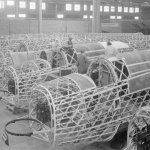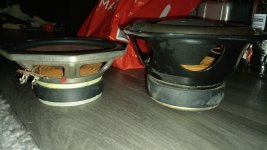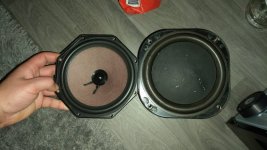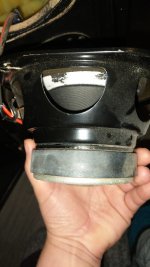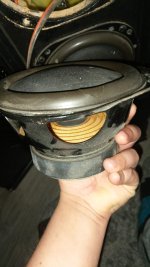I thought the Mossie was quite famous
Indeed. As a grade schooler i could draw the ost well known of all the WW2 fighters. After the Spitfire the Mosqito & the Hurricance were y favorites.

dave
...the A5.2 / A5.3 is a very nice little driver of its type.
Steve is a big fan of cone tweeters. He should have a look at these (or the CHN50 if budget is a concern) since it is a superb tweeter and can be used way down (250-450 Hz, depending on context).
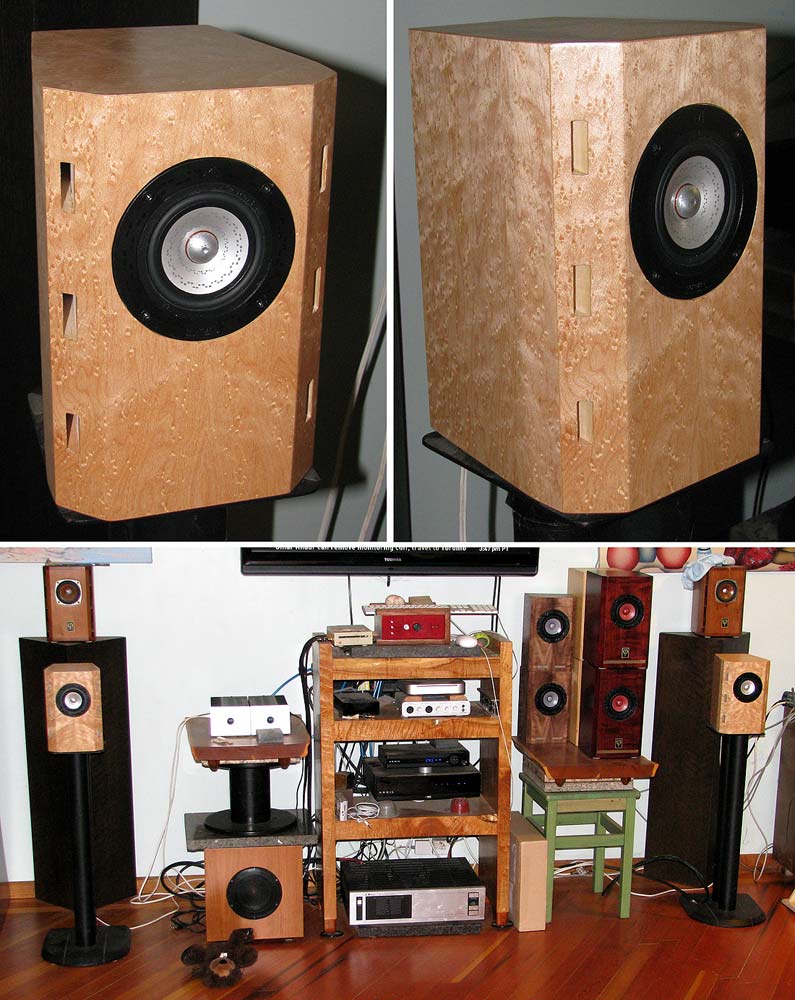
Would be a superb driver up top in an MJK sytle OB.
dave
Ah, the intoxicating aroma of polystyrene cement and enamel paint! And the de Havilland Mosquito was one of my favourite kits.
Post retiral, I've ensured that a couple of Mossie kits are included in my growing stash.
I bought a kit years ago. It's waiting patiently for me to retire.
jeff
Indeed. As a grade schooler i could draw the ost well known of all the WW2 fighters. After the Spitfire the Mosqito & the Hurricance were y favorites.
Good man.
The Mosquito & Beaufighter are my favourites of the heavy fighters / fighter-bombers. Old Whispering Death wasn't pretty, and it wasn't as quick, but it has that lurking in the shadows thing going for it. Especially in flat black. And 4 x 20mm Hispanos + 6 x .303 Brownings could really put a crimp on your day.
Ahem. Slightly off topic. Although structurally interesting; many parallels to be drawn between aircraft, motorsports and audio enclosures.
Steve is a big fan of cone tweeters. He should have a look at these (or the CHN50 if budget is a concern) since it is a superb tweeter and can be used way down (250-450 Hz, depending on context).
Right. It can work uncannily well, especially if you shove some hi-fi perceptions aside & just want to kick back and enjoy some music. I like quality domes; Scan's 6640, SB's ring-dome & beryllium Satori models are favourites for e.g. But I like cones as well. Partly from doing the MA-Sota range (within the company requirements). I'm working on a 2-way with the 5.3 at the moment for a musician friend who heard it & liked what could be done with it. When you've got the BW, it opens up a lot of options.
The paper is good but it is limited. And tech has improved since then (just today i read that NASA is opening up some of the decade old stores of moon-rock to test with new kit).
There have been a ton of papers since that time and none have completely nailed the issue.
Aye. I was never all that keen on the thin-wall BBC approach. It works OK (or perhaps I should say it can work OK), but most of the time I see measurements of applications, they never seem all that distinguished in terms of panel resonance. Harbeth seem to have some of the better examples of the breed.
Last edited:
Has geodetic (geodesic) design ever been applied to loudspeakers I wonder?Slightly off topic. Although structurally interesting; many parallels to be drawn between aircraft, motorsports and audio enclosures.
Attachments
Has geodetic (geodesic) design ever been applied to loudspeakers I wonder?
Yes, in a sense. Thick styrofoam cone with a film on the sound projection surface in the famous KEF B139 oval-like woofer.
B.
If anybody happens to have some experience with the (styrofoam coned) Sonics SLE 60/120 woofers, I'd like to know about it. I have been told its 'break up' resonance is at around 1100Hz. Don't know if they are true geodesic designs, there's not much info to be found on them. Can take a couple of pictures while refoaming if wanted.
I'm not refoaming yet, surrounds prove hard to find in the weird size used by this driver, the one I have found may prove to be too stiff...
The other (octagonal) driver in comparison is a Philips AD7066/W4 7 inch woofer.
These seem to have a very large xmech for their age?
The other (octagonal) driver in comparison is a Philips AD7066/W4 7 inch woofer.
These seem to have a very large xmech for their age?
Attachments
I am working on a thin wall speaker:
* Outside dimension like Harbeth SHL5
* bass reflex
* removable front and back baffle with wood screws
* High quality 10 mm birch plywood with oak veneer
* Vifa (ScanSpeak) NOS 8 inch woofer with coated paper cone, i have refoamed with foam suspension for higher fs
* ScanSpeak ring radiator tweeter
* 3rd order BBC style crossover with high quality Jantzen components
The next step is damping with self adhesive bitumen sheets used in cars. I use carpet glue because the self adhesive is loosening over time.
My questions is if someone have experience?
* 3 or 5 mm bitumen sheets?
* How much area should i cover in %?
* Is it smart to cover different %?
* How much loose damping material?
* Syntetic wool or merino?
* Felt?
* How hard should i screw the baffle?
Last but not least, should i do som frequency / impedance / distortion measurements during the process.

* Outside dimension like Harbeth SHL5
* bass reflex
* removable front and back baffle with wood screws
* High quality 10 mm birch plywood with oak veneer
* Vifa (ScanSpeak) NOS 8 inch woofer with coated paper cone, i have refoamed with foam suspension for higher fs
* ScanSpeak ring radiator tweeter
* 3rd order BBC style crossover with high quality Jantzen components
The next step is damping with self adhesive bitumen sheets used in cars. I use carpet glue because the self adhesive is loosening over time.
My questions is if someone have experience?
* 3 or 5 mm bitumen sheets?
* How much area should i cover in %?
* Is it smart to cover different %?
* How much loose damping material?
* Syntetic wool or merino?
* Felt?
* How hard should i screw the baffle?
Last but not least, should i do som frequency / impedance / distortion measurements during the process.
Last edited:
Use the butyl sheets with a layer of aluminum, not just a simple bitumen/butyl/rubber sheet. If you were in the US I would recommend Resonix.
100% wool batting for quilts is widely available and works great.
I recently did a test with a sorbothane gasket between driver and box, and rubber grommets between the screw head and the driver flange and that dropped energy being put into the box panels. The hardware store also had small Viton o-rings and these would probably work great too.
100% wool batting for quilts is widely available and works great.
I recently did a test with a sorbothane gasket between driver and box, and rubber grommets between the screw head and the driver flange and that dropped energy being put into the box panels. The hardware store also had small Viton o-rings and these would probably work great too.
I am working on a thin wall speaker:
The front baffle is thicker than 10mm?
The bitumen sheets in the BBC approach are to damp the large low frequency cabinet resonances as best one can using extensional damping (not the most efficient of approaches but cheap and easy). Since adding more bitumen is going to lower the frequency of the resonance (making it less perceivable) and increase the amount of damping (decreasing the magnitude of the resonance) this suggests thick large coverage is the way to go.
The internal acoustic damping material shouldn't be too loose. It needs to be kept away from the port/s and out of the coil gap. It is best located towards the centre of the speaker where the particle velocity is largest to damp internal resonances and to sit between the driver and port to minimise the amount of midrange sound leaking out the port and driving port resonances.
Normally the side walls stiffen the front baffle (a stiff baffle is needed so that it moves little when vibrated by the drivers hence minimising the energy put into the cabinet that will be radiated away as sound or absorbed by the structural damping) making a strong joint desirable. However, strong joints will raise the lowest frequency resonances which is undesirable in the BBC approach. It isn't clear to me which of several competing bits of physics will be dominant in your case. But a stiff baffle is always desirable whatever approach is taken for the other 5 sides.
Personally I would measure at several locations the cabinet response to a weighted tap before adding the damping and after. This should show the effect of the damping which if in line with that shown in the BBC publications will build confidence.
If you can see cabinet resonances in an impedance sweep, whether acoustic or structural, they are likely to be audible. I would again be tempted to do this both before and after adding the structural and acoustic damping as a check that things are behaving as intended. I would also suggest looking at the output of the port while arranging the internal damping to check the midrange frequencies/resonances are improved and that the main incompressible resonance is not being noticeably impeded.
- Home
- Loudspeakers
- Multi-Way
- Interesting read I found on Lossy Cabinet designs by Harbeth
